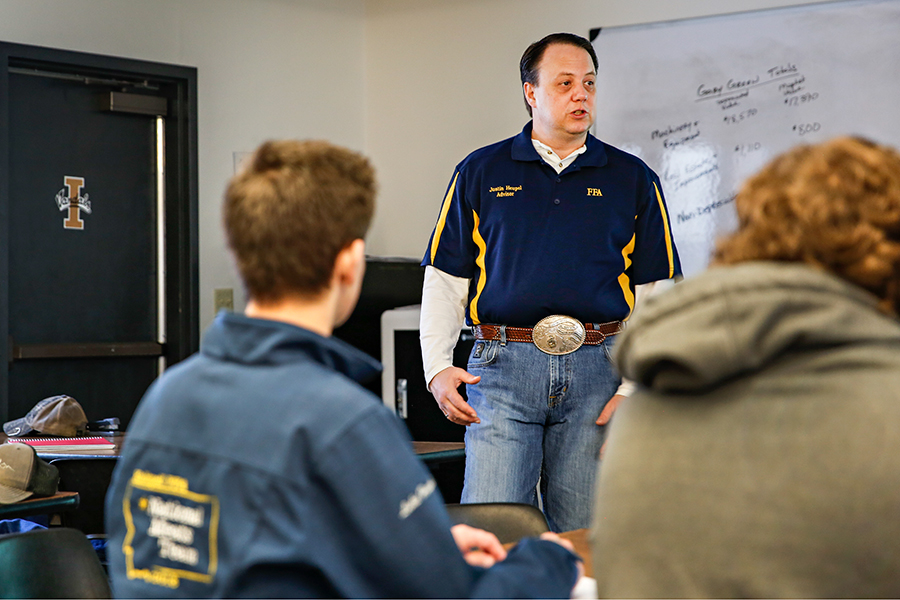Feeding the Future
Flathead and Glacier high school students get a crash course in farming, ranching and more at the freshly renovated H.E. Robinson Agricultural Education Center
By Andy Viano
Students at Kalispell’s two public high schools have options to fulfill the district’s elective course requirements and graduate. Among the choices in the career and technical realm, students can study business, learn industrial tech or prepare for their future with a family consumer science course. Or, they can hop on a bus from Flathead or Glacier high school every day and head south, to one of the few working farms operated by a school district in the state of Montana.
Kalispell’s Agricultural Education Center opened in 1977, and in the last 43 years students have been learning the ins and outs of the agricultural business while playing a major role in the operation of the farm itself. Classes at the center instruct on raising livestock, harvesting grain, operating heavy machinery and a number of other skills that teachers there say are preparing students for success in a wide array of careers.
“A lot of times when we think about agriculture we think about farming and ranching but there’s more than 300 career titles in ag,” Justin Heupel, an agricultural education teacher and the department leader, said. “We can’t forget about the agronomist and the feed salesman and the veterinarian, even the engineers … it’s preferred that all those folks have some kind of background in order to better support all the things that it takes to get from farm-to-fork or gate-to-plate.”
Students can take anywhere from one ag class at the center to four years worth of offerings, and most of the more agriculture-focused students will also join the Kalispell FFA, which is led by instructors at the Ag Center. Brian Bay is one of those instructors, joining the Ag Center staff after 10 years working in agricultural and construction jobs, and among his responsibilities is supervising the school’s beef program where he guides students through just about every step of a process that ends with some cows sent to Lower Valley Meats for processing and resale in the Flathead Valley.
“They brand, they vaccinate, they weigh calves,” Bay said. “And then we come up with a plan; when to sell them and select which ones we keep.”
Bay’s reproduction unit covers the very first stages of life, allowing students to leaf through bull catalogs, compare options, and select which bulls will be suppliers for the artificial insemination they will conduct as part of the same course. And at the other end of the life cycle, the farm sells calves, cows, lambs and market hogs, giving students the opportunity to learn the business side of agriculture in a real-world setting.
Livestock is not the only thing at the Ag Center either. The farm has a large greenhouse that grows a vast selection of flowers and sells several hundred tomato and pepper plants each year. Straw, hay and 2,000 bushels of barley are grown on the farm as well, with students learning to mix the grain for the animals on top of tending to the crops.
The property where all this work is done was showing major signs of wear in 2016 when voters approved a $54 million bond package for School District 5 that included the first major improvements, about $6 million worth, at the Ag Center since the building opened more than 40 years ago. That work is finally nearing its conclusion and the result is a main school building with renovated classrooms, an updated computer lab and meeting space, a new veterinary science building and a major overhaul to the shop area where mechanical trade classes, another part of the Ag Center’s curriculum, are held.
In the vet science building, additional pens for sheep and lambs along with a few webcams allow Bay to monitor the lambing process from home, and an advanced tool to hold the head of a thousand-plus pound cow in place during examinations is a welcome safety improvement.
There are around 320 students taking classes at the Agricultural Education Center this semester, many who will not go into a field in any way relating to this part of their education, but to Heupel the lessons those students learn are valuable far beyond the workplace.
“There’s the hard skills and the industry but there’s also the consumer piece,” he said. “That knowledge of where does my food come from and how is it produced and why are these modern practices important. For many of them, at the very least, it probably makes a trip to the grocery store less complicated.”
For those who do want to find their way into the industry, specialized learning can be found through the FFA but the teachers at the Ag Center believe in a more rounded curriculum, one that teaches basic principals of everything the school offers. That decision, which bucks a national trend toward more specialized coursework, is in response to the community’s needs, Bay said, and in response the community has responded to theirs.
“Employers want well-rounded kids. They want employees to know a little bit about how stuff works,” he said. “I think we’re doing it right, and we have some confirmation here, because our community just passed this huge bond and we got $6 million to build this.”
The School District 5 Agricultural Education Center is located at 310 FFA Drive in Kalispell. For more information, visit sd5.k12.mt.us/10/home.